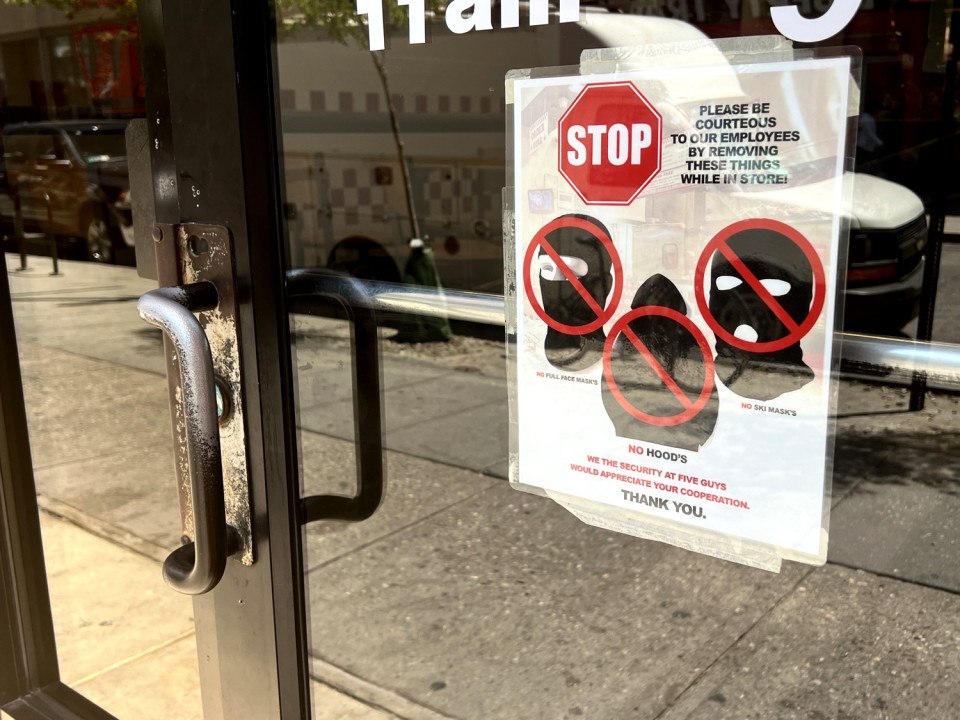Banning “Shiesty” Ski Masks on SEPTA Won’t Reduce Crime
The transit agency's recent policy banning the "shiesty," a type of ski mask worn largely by Black teens, is just another performative anti-crime stunt that won't change a damn thing.

A sign banning ski masks on a Chestnut Street storefront. / Photograph by Laura Swartz
Things have gotten so desperate around here that people and organizations have reached the “Do something, do anything” phase of the Philly gun-violence crisis. The city previously dumped millions of dollars into anti-gun violence programs — and the the effectiveness of that spending is an open question. Now, major institutions are making questionable decisions of their own.
Last week, SEPTA police announced a ban on riders in ski masks after a suspect wearing one fatally shot a 15-year-old high-school student on one of its buses in Germantown.
“Those face masks are prohibited on SEPTA property,” SEPTA Transit Police chief Charles Lawson said at a press conference last Thursday. “If you come on SEPTA property wearing your shiesty, you will be engaged by police. So I want you to think about it.”
SEPTA’s new policy isn’t just a reactive attempt to confront crime; it’s a dated, anti-Black stunt that scapegoats hip-hop culture.
A brief history: The recent rise in Black youths wearing ski masks began during the pandemic. A Memphis rapper named Pooh Shiesty donned one for his music videos before eventually being incarcerated in Florida on a gun charge. The masks soon became popular in New York’s “drill” rap-music scene, with people dubbing the ski mask a “shiesty.” Conflating this with a rise in crime, New York City mayor Eric Adams declared war on drill rap and shamed social media platforms for “allowing music, displaying of guns, violence.”
Similar rhetoric made its way into our mayoral race as candidates and community members also began to conflate masks and violent crime. Some public-policy wonks in the region have argued that City Council should ban the shiesty because “we see young men committing violent crimes while wearing these masks.” While on the campaign trail, former Democratic mayoral candidate Amen Brown proposed enforcing a citywide ban on ski masks, telling the press at the time that “it is not okay for three or four or five individuals to be riding around with ski masks on, making law-abiding citizens feel like they’re about to be the next victim.”
And therein lies the problem: This ban on ski masks is about respectability politics. It’s an attempt to police the behavior of the Black youths who wear them and not the application of empirical data to find alternative solutions. Sure, one could argue that banning such masks could reduce a criminal’s ability to obscure the face. But in a world where people still wear face masks due to COVID and others cover their faces for religious purposes, the slope can get very slippery very quickly.
This feels all too familiar.
I grew up Black and attended urban public schools. That meant I was stereotyped regularly. Throughout my elementary-, middle- and high-school years, I encountered campus-wide bans on wearing Dickies cargo pants, bandanas, hoodies, earrings, neck chains, and any type of sagging pants. The reasoning? Most of that attire was allegedly connected to — say it with me — gang activity. After I graduated from Penn, I encountered racially motivated dress codes at Gayborhood bars that banned Timberland boots and Adidas track pants.
History proves that such actions do more harm than good. School dress codes too often cross a line and violate individuals’ civil rights. Criminalizing hip-hop music and culture has been shown not to reduce crime. And the cities that succeed in passing such ordinances — I’m thinking of the various saggy-pants bans in parts of Florida — face ongoing legal battles.
I say this to city institutions: If you want to ban the shiesty because you’re uncomfortable with Black kids in public who have their faces covered, just say it. But own up to the implicit bias, double standard and racism that stance signals. Despite a surge in hate crimes fueled by far-right groups, I’ve yet to see a single ban on those divisive red MAGA hats largely worn by white men. In both cases, a performative fashion ban won’t address the bigger issues behind crime and white supremacy that transcend attire.
In 2000, City Council passed an ordinance banning facial coverings during the Republican National Convention that was hosted here that year. The rationale? To prevent known hate groups like the Ku Klux Klan from being able to “intimidate or threaten another person” or “hide” their identity when attempting to harm residents. Banning hoods did no more to curb white supremacy than banning shiestys will to reduce crime.
To think that 23 years later, city leaders would consider banning a popular hip-hop fashion trend — one that will certainly fade just like throwback jerseys, super-baggy clothing, sagging and platinum mouth grills — proves we haven’t learned anything. At this point, everyone should calm down, do the research — and then come back to the table with solutions that will actually work, because this ain’t it.


